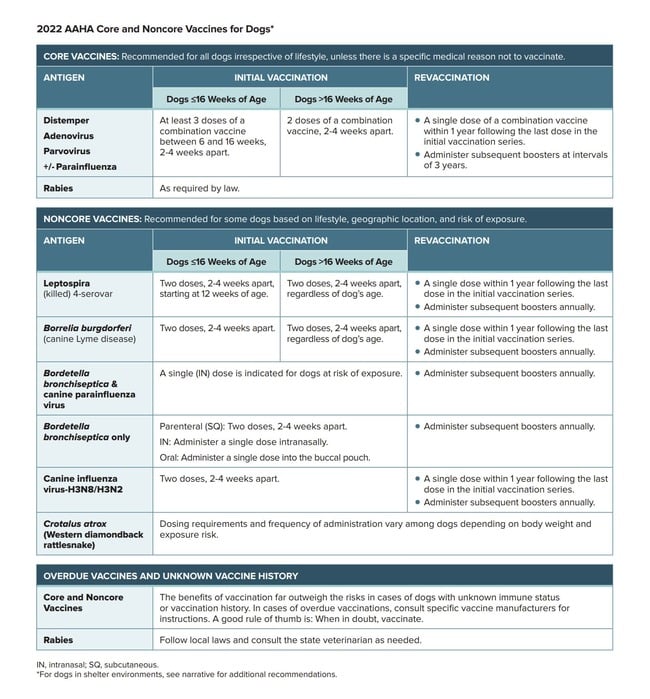
If you go to the American Animal Hospital Association or the American Veterinary Medical Association websites and search for core vaccines, you’ll find that the core vaccines—distemper, hepatitis, parvo, and rabies—should be given no more often than every 3 to 5 years. It’s really more like 5 to 7 years.
Veterinarians who insist on yearly dog vaccines for the core vaccines are out of touch. Worse, they are not even following the rules of their own association, the American Veterinary Medical Association. If you have such a vet, perhaps it’s time to start looking for a new vet who is up to date. And if you’re in the market for a holistic vet, this map will help you find one near you.
VACCINE PROTOCOLS
| Age Range | Vaccines/Titers | Notes |
|---|---|---|
| *9-10 weeks | Initial core DAP vaccines (distemper, adenovirus, parvovirus) |
If maternal immunity is unknown and the puppy is in a high-risk environment |
| *14-16 weeks | Second round of core DAP vaccines | Some puppies require a 3rd round at ~18-20 weeks based on environmental risks |
| 4 weeks after second round of core vaccines |
Titer to verify immunization, not just vaccinated |
Titers are an antibody test to help determine immunity |
| 6-12 months | Rabies | As required by law |
| 1 year | Titer to verify immunized and only vaccinate if needed |
Before automatically revaccinating, titer first. Continue rabies as required by law |
*If puppies were kept in a safe environment and had good maternal protection (based on having a mother with good titers before breeding), our preference for our personal pets is to wait until 16 to 18 weeks to give the parvovirus vaccine, then distemper and adenovirus 2-3 weeks after that.
(The above chart was excerpted from Dr. Judy Morgan’s and Rachel Fusaro’s Holistic Guide to Vaccinations. Click to view the full PDF.)
My dogs do get the core vaccines, and then I titer at 3 and 5 years. I am not against vaccines, but there is no benefit to over-vaccinating, while there are potential health risks.
Non-core Vaccines
With non-core vaccines (eg bordetella, Lyme, lepto, and canine influenza), each of us need to individually assess the likely exposure and risk of getting such diseases based on where we live and where we take our dogs. Because ticks and tick-borne diseases are rampant where I live, those are a no-brainer for me. You should check with your veterinarian to determine the best vaccine protocol for your individual pet.
Affordable Titer Tests
According to AAHA (American Animal Hospital Association): “Measuring antibody levels (quantitative or qualitative) provides a reasonable assessment of protective immunity against CDV, CPV, and CAV2.” A titer test can help determine antibody levels from a blood draw at your vet clinic. This is a test that can help assess a dog’s protection from diseases (eg distemper, adenovirus), by verifying if the dog has been immunized and not just vaccinated. And titer tests can help when you don’t know a dog’s vaccination history.
If you think you might like to try titering instead of automatically revaccinating, here are a few affordable places. Your vet will also have their own resources for this service as well.
Titer Test
Hemopet
Protect the Pets
*DISCLAIMER: I am not a veterinarian and am not prescribing what you should do. I am only sharing what I do for my dogs. Please consult your primary care vet on the best vaccination protocol for your pet.
Here is the latest AAHA-Core-non-core-vaccines-for-dogs. Click on the image to see the full size.


Related Posts: